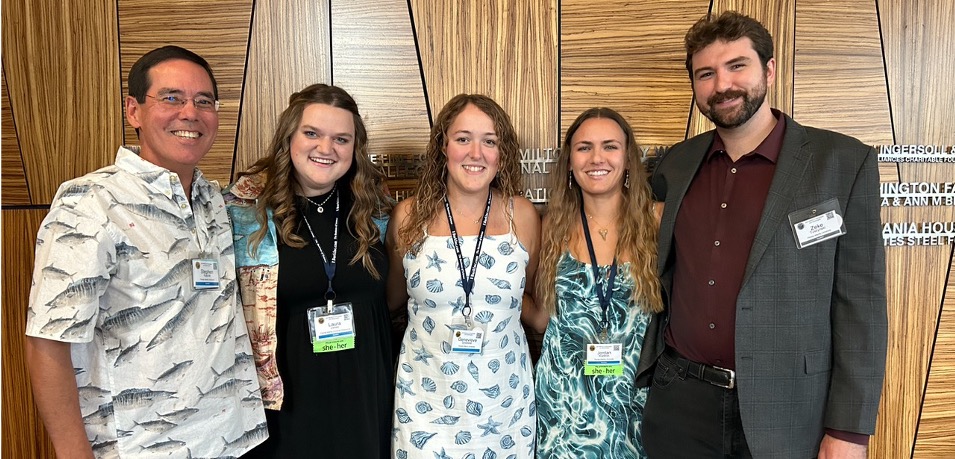
JMIH 2024: Marine Lab scientists present shark and ray research in Pittsburgh
Author: Hannah Mauer
Date: September 22, 2024
In July of 2024, FAU Marine Lab students, faculty, and alumni from the Elasmobranch (Elasmo) Lab and Florida Atlantic Biomechanics (FAB) Lab attended the Joint Meeting of Ichthyologists and Herpetologists (JMIH) in Pittsburg, Pennsylvania. Our team presented their research to other fishy (ichthyologists) and reptilian (herpetologists) scientists, showcasing recent shark and ray studies. Awards were received by various lab members! Read about all these impressive presentations here.
- Gabriella Castillo, an undergraduate student in the FAB Lab, took a close look at shark noses by analyzing olfactory (smell-detection) structures of the Pacific spiny dogfish through scanning electron microscopy (SEM) imaging. (For more on the power of SEM imaging, check this out). She mapped the sensory areas of the several lamellae that make up the larger olfactory structures (rosettes) in these sharks’ noses. Gabriella found that lamellae in the center of the rosettes were larger with more folds than at other parts of the rosette. These differences in morphology suggest that shape affects how water flows through the nose, and so, how it detects odors in the water.
- Aubrey Clark, a Ph.D. candidate in the FAB Lab, compared the 3D morphology of shark olfactory rosettes using microCT (similar to a high-resolution CAT scan). By comparing the morphology of different shark species, Aubrey is beginning to catalogue how water flows through the olfactory system. Differences in these hydrodynamic flows may explain the broad range of sizes, shapes, and internal arrangements observed in the olfactory rosettes of different shark species. Aubrey is interested in more than the shark nose. She also presented studies comparing the mechanical properties of cartilaginous vertebrae in the anterior, middle, and posterior spinal regions of different shark species. These differences in vertebrae are believed to determine how sharks bend as they swim. Aubrey is doing it all!
- Dr. Marianne Porter, head of the FAB Lab, studied kinematic differences in straight swimming, maneuvering, and feeding behavior of juvenile scalloped hammerheads. She found velocity was lowest during feeding while body curvature increased during feeding behavior, and that body curvature decreased as velocity increased. These findings ultimately expand our understanding of the relationships between form and function.
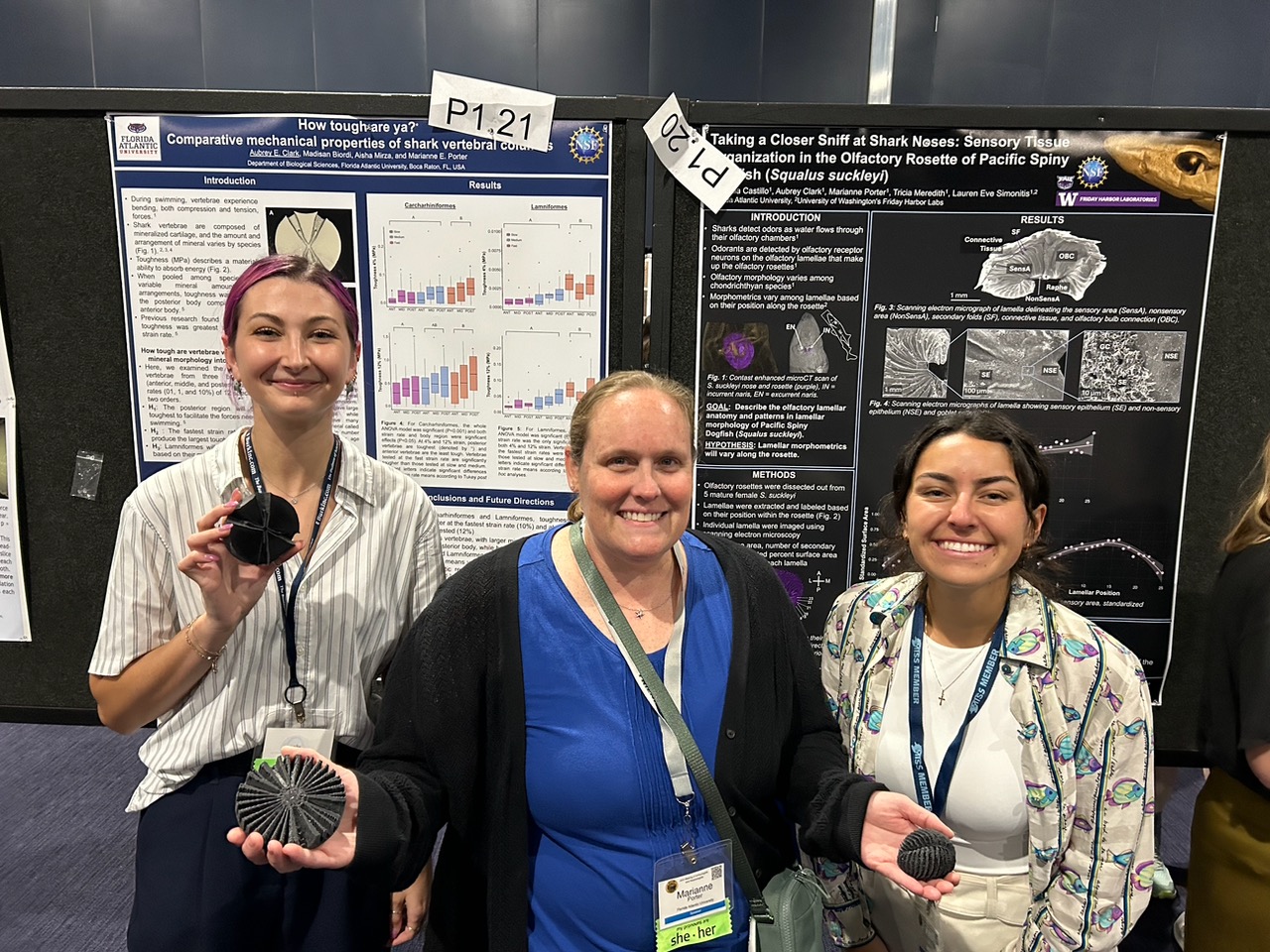
- Jordan Waldron, a Ph.D. student in the Elasmo Lab, studied the spatial distribution of whitespotted eagle rays, using aeriel surveys in the Florida Keys. Initial results show that rays are present in the Florida Keys year-round, with peaks during March and April. Jordan plans more aerial surveys to solidify her conclusions, and hopefully lead to more effective management of the species. Jordan received the Donald R. Nelson Research Award for her work – way to go, Jordan!
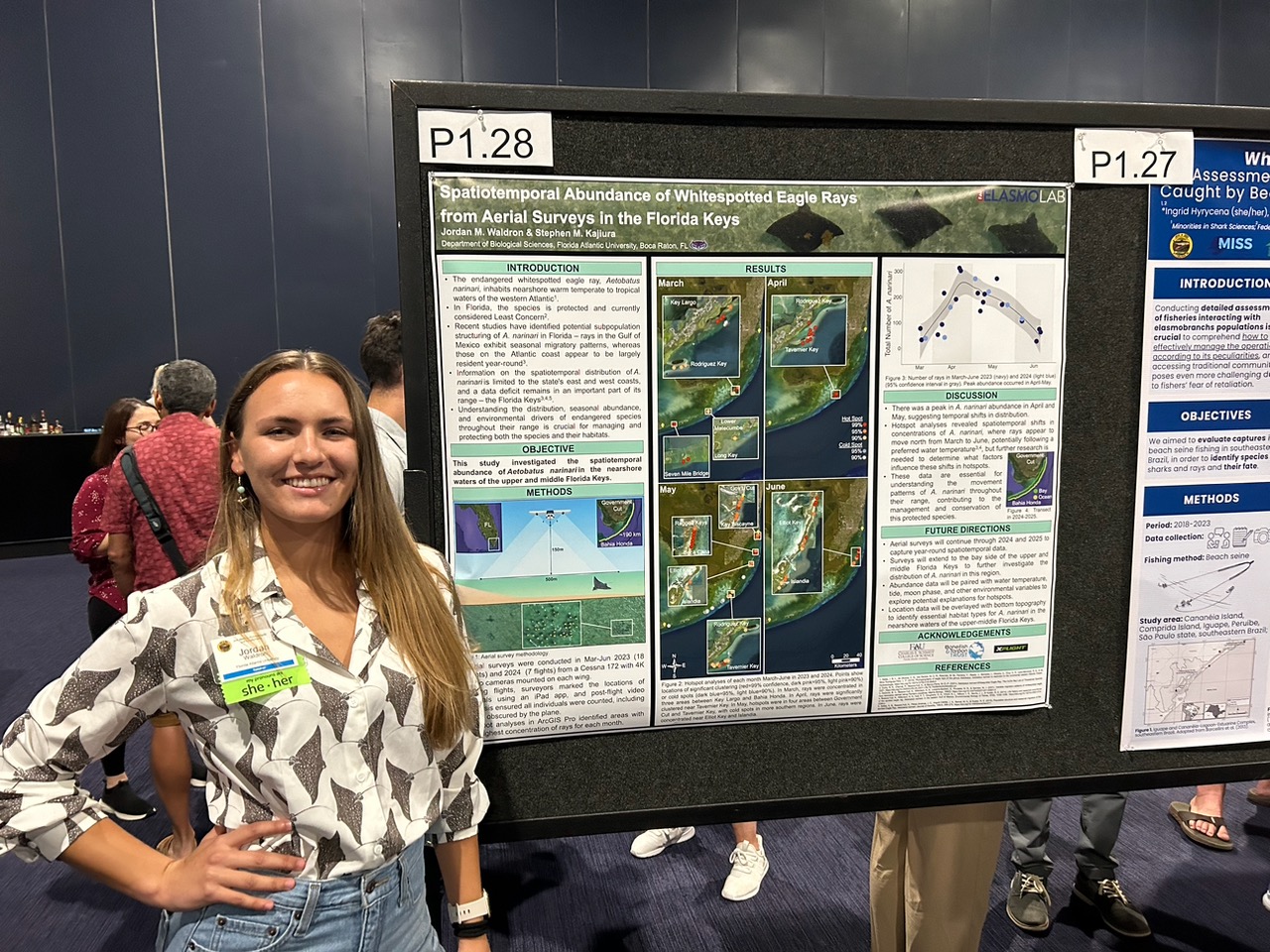
- Isaac “Zeke” Tuszynski, a M.S. student in the Elasmo Lab, used fin-mounted satellite transmitters to determine how environmental factors shape blacktip shark migrations. His tracking data revealed that blacktip sharks often stay within 70 meters of shore and spend approximately 70% of their time in water between 22°C - 26°C (that’s 72-79°F). It is likely that the blacktip sharks leave southeast Florida waters in the spring and head north in favor of water temperatures that do not exceed this thermal preference range. Zeke received a Travel Award to attend the meeting!
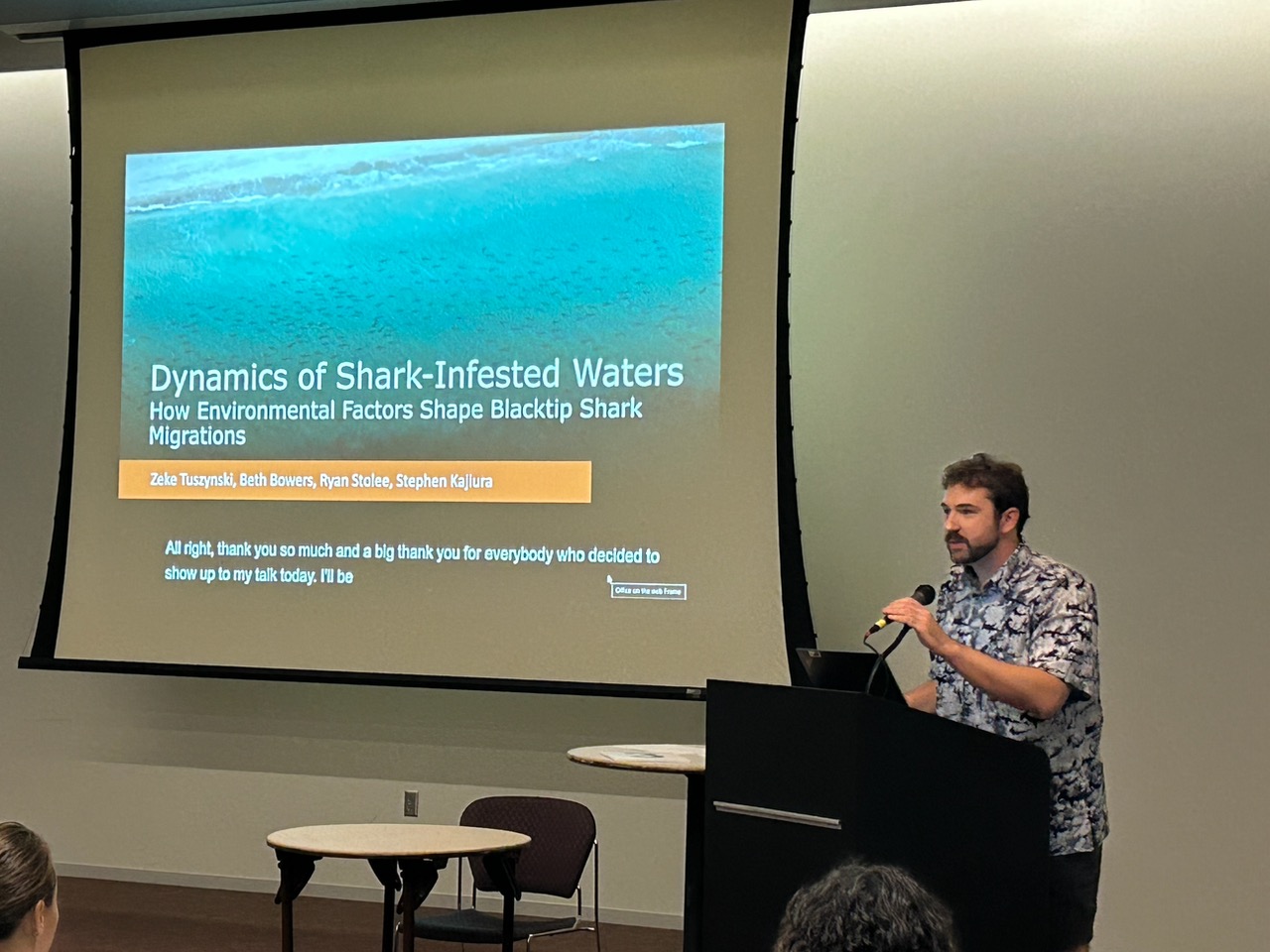
- Dr. Stephen Kajiura, who heads the Elasmo Lab, reported on the efficacy of a novel electrogenic deterrent to reduce incidental shark capture in longline fisheries. These novel deterrents juxtapose zinc and graphite together on fishing hooks, resulting in a reaction that overstimulates the shark’s electrosensory system and deters sharks from biting. Significantly fewer sharks were caught with the zinc/graphite hooks than the controls (plastic controls and bare hooks), suggesting that these experimental hooks can reduce shark bycatch by as much as 60 – 70%. Further studies will be conducted to determine if decreasing shark bycatch favors an increase in the catch of target fish species.
Additionally, several FAU Marine Lab alumni presented their research contributions.
- Caroline Sullivan, who studied responses of blacktip sharks to sounds, found that the sharks could detect and orient away from sound sources at least 62 meters away. These observations were important because previously, sharks were believed incapable of determining the location of distant sound sources.
- Laura Jones determined that “Zepplin” magnetic sinkers, deployed on baited hooks, significantly deterred more sharks than the control sinkers. Shark bycatch and depredation (consumption of the target catch) are increasing concerns in fisheries worldwide, so these deterrents could have a major impact on the fishing industry. Next, she plans to test whether these sinkers also deter sharks when live fish are used as baits. That configuration will provide a better representation of real bycatch and depredation incidents.
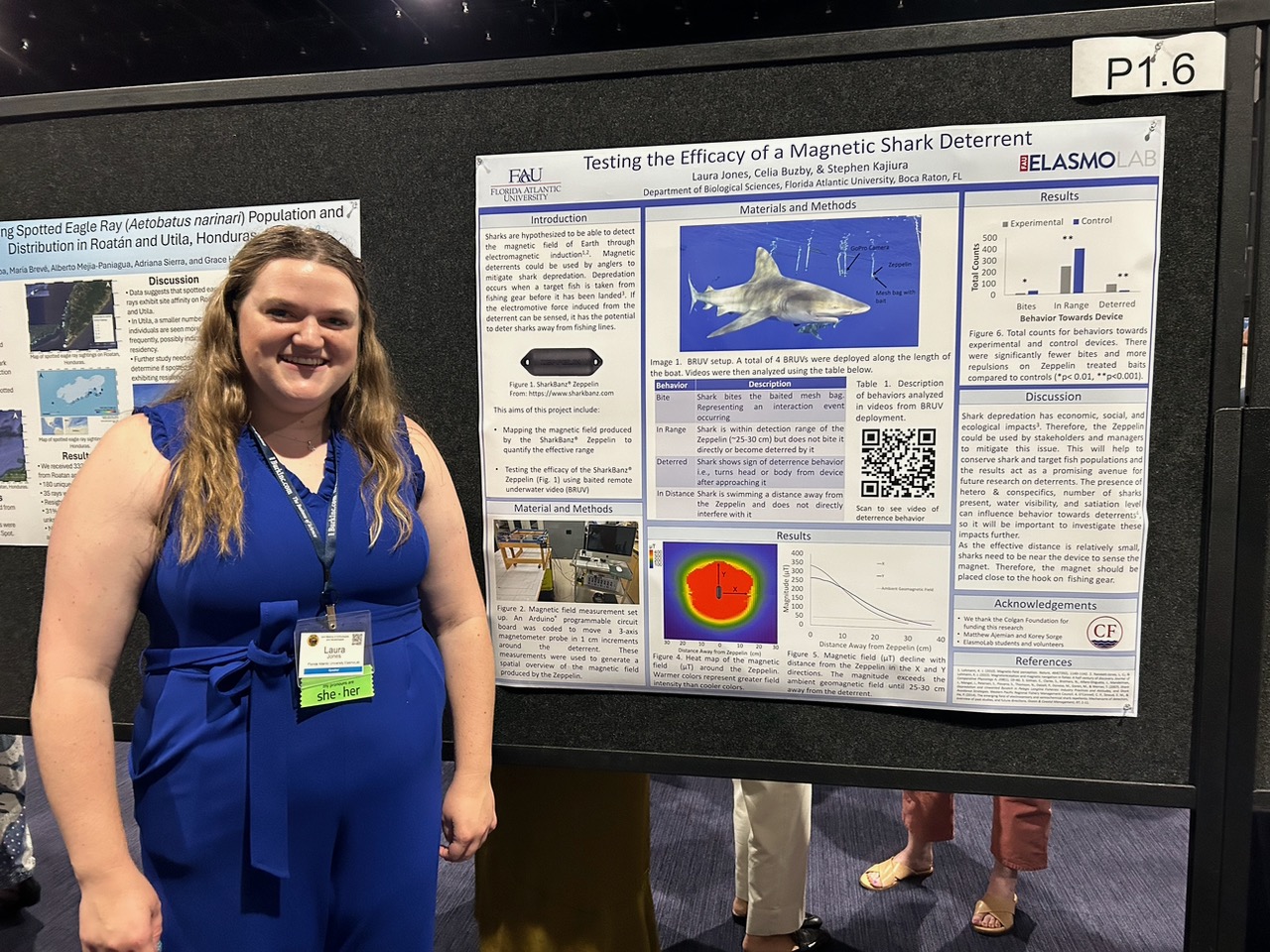
- Dr. Kyle Newton investigated the impact of anthropogenic electromagnetic fields (EMFs) on skates (relatives of rays). As the use of renewable energy increases worldwide, this often involves electricity transported through subsea cables. Natural geomagnetic features of the earth are used by many kinds of animals for navigation and could be disrupted by these artificial EMFs. Kyle used an experimental technique called geomagnetic displacement to see if skate behavior was disrupted by artificially generated geomagnetic information. Kyle’s results varied for two skate species (large skate and longnose skate). Large skates became more active while longnose skates were less active overall. He plans additional experiments to determine whether anthropogenic EMFs affect elasmobranch navigation.
- Cecilia Hampton received the Gruber Outstanding Oral Presentation award for her work using novel multi-sensor tags to understand the foraging ecology of rays that feed on hard-shell prey. She was able to map behaviors of these rays including feeding, as well as interactions with other rays. These novel tags will help researchers better understand the role of these predators that play a pivotal part in marine food webs.
- Eloise Cave studied adaptive genetic variation in tiger sharks across the western North Atlantic. Adaptive variation plays a key role in a species’ ability to contend with changing environments. Despite close spatial proximity, her study found three genetically distinct tiger shark groups that were associated with different environmental factors. This suggests tiger sharks may adapt to local environmental conditions, which is important for conservation efforts. Eloise received the American Elasmobranch Society (AES) Meritorious Service Award!
- Dr. Mikki McComb-Kobza tested the efficiency of non-invasive methods, such as baited remote underwater videos BRUVs, to detect western North Atlantic white sharks. In addition, she surveyed waters for environmental DNA (eDNA) left in sites that the sharks visited. Sharks shed bits of DNA through mucus and feces that can be detected in water samples. These non-invasive techniques will be used to improve estimates of the relative abundance of these sharks. Mikki also received the AES Meritorious Service Award!
We are so proud of our shark researchers – way to go!
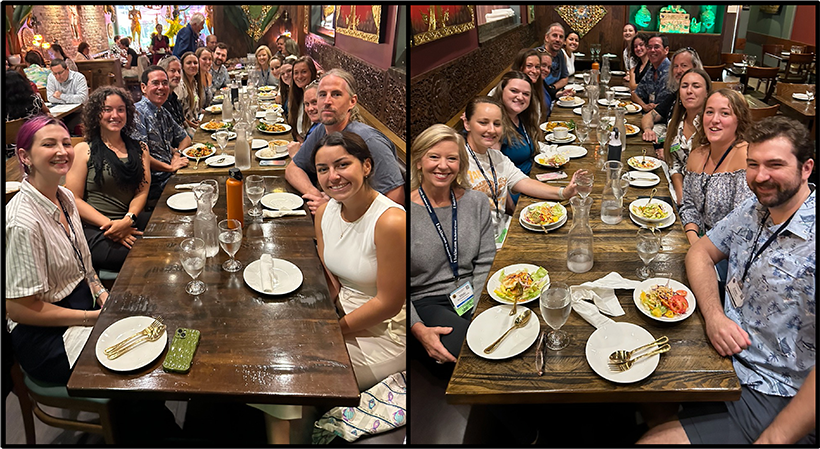
|
| All current and past members of the Elasmo and FAB Labs attending JMIH gathered for a nice dinner together. There was so much awesomeness at one table, we had to give you the view from each side! |





